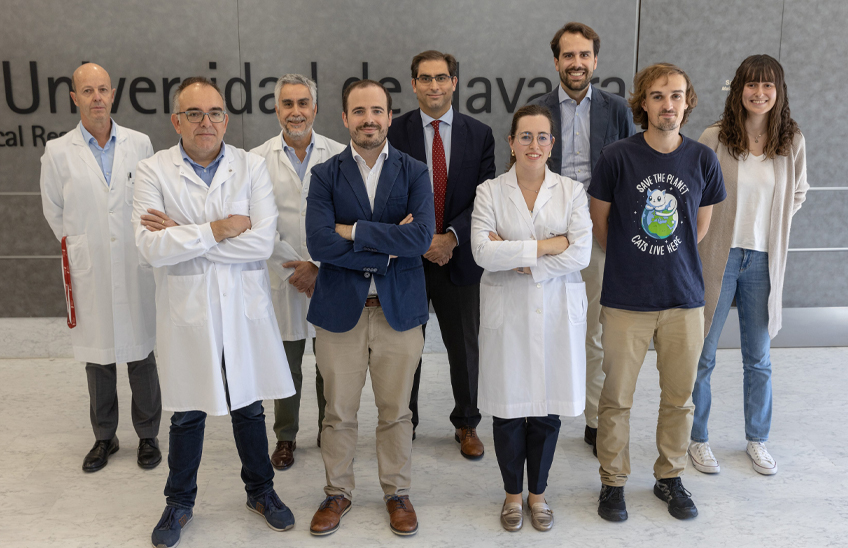Mathematical algorithms to curb cancer growth
Nature Communications publishes a work with a new computational method led by University engineers.

PhotoManuelCastells/From left to right: Felipe Prósper, Antonio Pineda, Francisco Planes, Iñigo Apaolaza, Naroa Barrena, Xabier Agirre, Luis Vitores Valcarcel, Ana Valcárcel and Danel Olaverri.
24 | 10 | 2024
A team of engineers from Tecnunthe School of Engineering of the University of Navarra, has created a new mathematical algorithm that makes it possible to study the metabolism of cancer and locate its vulnerabilities in order to slow down its growth. This has been reported in a article published in the journal Nature Communications.
As explained by the main Tecnun researcher who has directed the project, Francisco Planes, the work is materialized in a tool web that can identify new ways to slow down the metabolism of tumor cells, preventing their growth and progression. "We are tackling a very complex problem, with thousands of variables, given the flexibility of cell metabolism and the different ways that tumors develop to feed themselves and continue to grow," says the Tecnun professor Full Professor . However, continues Planes, "our tool shows that metabolic vulnerabilities of tumors can be identified. Blocking these vulnerabilities is lethal for tumor growth, similar to the effect of cutting a main road on a highway network ".
The tool has been validated by the Cimaresearch center average Applied Medicine at the University of Navarra, whose scientists have used it to study the metabolism of multiple myeloma, "the third most common hematological malignancy, with a patient survival rate of approximately 24 months", as highlighted by Felipe Prósper, co-director of the Hemato-Oncology Program at . As described in the , Prósper explains, "the has made it possible to predict the therapeutic potential of inhibiting two proteins (CTPS1 and UAP1) in this disease. The in vitro experiments carried out by our team confirm these findings." Cima work tool
In addition, as expressed by the engineer Luis Vitores Valcárcel, first author of work, which is part of his doctoral thesis , "is a simple and accessible tool for academic community, with the ability to be applied to any cancer subject and without the need for the intervention of an expert in bioinformatics".
It should be noted that the group of research of Computational Biology of Tecnun, at partnership with the group of Hemato-Oncology of Cima, has been working on the study of cancer metabolism since 2012, thanks to funding obtained from different public and private institutions. The work published in the latest issue of Nature Communications integrates multiple improvements with respect to the article that was published in this same journal by the engineering team in 2017.
According to Tecnun's researcher Francisco Planes, the advances are largely due to the updates that the metabolism map has undergone in recent years, as well as the establishment of massive sequencing technologies in biomedical research . "Our tool integrates these sources of information and improves the predictive capacity of existing algorithms with new elements at the mathematical and computational level," he concluded.
The work has been carried out with public funding from the department of Education and Industry of the Basque Government, the Ministry of Economics and Competitiveness and with the financial aid of private institutions such as the association Española Contra el Cáncer and the Ramón Areces Foundation. In addition, it has been carried out at the framework of the Institute of research Sanitaria de Navarra (IdiSNA) and the Ciber de Cáncer (CIBERONC).
article published in Nature Communications (October 11, 2024)




